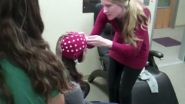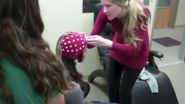(Press-News.org) VIDEO:
UC Davis researchers found that the pattern of electrical activity in the brain immediately before making a decision can predict the choice made. This video shows how these experiments are...
Click here for more information.
Our ability to make choices — and sometimes mistakes — might arise from random fluctuations in the brain's background electrical noise, according to a recent study from the Center for Mind and Brain at the University of California, Davis.
"How do we behave independently of cause and effect?" said Jesse Bengson, a postdoctoral researcher at the center and first author on the paper. "This shows how arbitrary states in the brain can influence apparently voluntary decisions."
The brain has a normal level of "background noise," Bengson said, as electrical activity patterns fluctuate across the brain. In the new study, decisions could be predicted based on the pattern of brain activity immediately before a decision was made.
Bengson sat volunteers in front of a screen and told them to fix their attention on the center, while using electroencephalography, or EEG, to record their brains' electrical activity. The volunteers were instructed to make a decision to look either to the left or to the right when a cue symbol appeared on screen, and then to report their decision.
The cue to look left or right appeared at random intervals, so the volunteers could not consciously or unconsciously prepare for it.
The brain has a normal level of "background noise," Bengson said, as electrical activity patterns fluctuate across the brain. The researchers found that the pattern of activity in the second or so before the cue symbol appeared — before the volunteers could know they were going to make a decision — could predict the likely outcome of the decision.
"The state of the brain right before presentation of the cue determines whether you will attend to the left or to the right," Bengson said.
The experiment builds on a famous 1970s experiment by Benjamin Libet, a psychologist at UCSF who was later affiliated with the UC Davis Center for Neuroscience.
Libet also measured brain electrical activity immediately before a volunteer made a decision to press a switch in response to a visual signal. He found brain activity immediately before the volunteer reported deciding to press the switch.
The new results build on Libet's finding, because they provide a model for how brain activity could precede decision, Bengson said. Additionally, Libet had to rely on when volunteers said they made their decision. In the new experiment, the random timing means that "we know people aren't making the decision in advance," Bengson said.
Libet's experiment raised questions of free will — if our brain is preparing to act before we know we are going to act, how do we make a conscious decision to act? The new work, though, shows how "brain noise" might actually create the opening for free will, Bengson said.
"It inserts a random effect that allows us to be freed from simple cause and effect," he said.
The work, which was funded by the National Institutes of Health, was published online in the Journal of Cognitive Neuroscience.
Bengson is also currently a visiting assistant professor at Bates College, Maine. Co-authors on the paper are Todd Kelley, postdoctoral researcher, Center for Mind and Brain; Professor Jane-Ling Wang and graduate student Xiaoke Zhang, Department of Statistics; and Professor George (Ron) Mangun, Center for Mind and Brain and dean of the Division of Social Sciences at UC Davis.
INFORMATION:
Does 'free will' stem from brain noise?
2014-06-09
ELSE PRESS RELEASES FROM THIS DATE:
Humanitarian liking on Facebook
2014-06-09
"Liking" a page on the social networking site Facebook is a new form of civic engagement and humanitarian support, so concludes research published in the International Journal of Web Based Communities. According to the paper's authors social motives and an emotional response underpinned users' inclination to like, or follow, a page, rather than their simply seeking information and news.
Petter Bae Brandtzaeg and Ida Maria Haugstveit of Scandinavian research organization SINTEF in Oslo, Norway, surveyed more than 400 Facebook users about their habits on the site and their ...
Berkeley Lab researchers create nanoparticle thin films that self-assemble in 1 minute
2014-06-09
The days of self-assembling nanoparticles taking hours to form a film over a microscopic-sized wafer are over. Researchers with the U.S. Department of Energy (DOE)'s Lawrence Berkeley National Laboratory (Berkeley Lab) have devised a technique whereby self-assembling nanoparticle arrays can form a highly ordered thin film over macroscopic distances in one minute.
Ting Xu, a polymer scientist with Berkeley Lab's Materials Sciences Division, led a study in which supramolecules based on block copolymers were combined with gold nanoparticles to create nanocomposites that ...
'Hello, world!' NASA beams video from space station via laser
2014-06-09
"Hello, World!" came the message from the International Space Station as NASA successfully beamed high-definition video via laser from space to ground on Thursday, June 5. The 175-megabit video transmission was the first of its kind for the Optical Payload for Lasercomm Science (OPALS) with the goal of improving the way we receive data from orbit and beyond. In fact, this emerging technology of optical communications--or lasercomm--is likened to an upgrade from dial-up to DSL.
"It's incredible to see this magnificent beam of light arriving from our tiny payload on the ...
African-American women more likely to be diagnosed with higher risk breast cancer
2014-06-09
Washington, D.C., June 9, 2014 - A research study led by cancer specialists at MedStar Washington Hospital Center found that African-American women frequently present with biologically less favorable subtypes of breast cancer.
Researchers at the Hospital Center's Washington Cancer Institute analyzed the biology of breast cancer in 100 African-American women, using a method of genomic profiling. These genomic tests look at the expression of genes associated with the risk of recurrence in the population and further characterizes the biology of the tumor. The 70-gene MammaPrint ...
Affordable housing linked to children's test scores
2014-06-09
It's long been accepted – with little science to back it up – that people should spend roughly a third of their income on housing. As it turns out, that may be about how much a low-income family should spend to optimize children's brainpower.
Johns Hopkins University researchers have explored the effects of affordable housing on the cognitive development, physical health, and emotional wellbeing of children living in poverty. How much a family spends on housing has no impact on a child's physical or social health, they found, but when it came to cognitive ability, it ...
New study finds text messaging program benefits pregnant women
2014-06-09
WASHINGTON, DC (June 9, 2014) – The leading mobile health service in the nation, Text4baby, was found to significantly benefit pregnant women, according to a new study led by Milken Institute School of Public Health (Milken Institute SPH) at the George Washington University and the Madigan Army Medical Center. The pilot study examined several things including the short-term effects of Text4baby exposure four weeks post enrollment on attitudes, beliefs and behaviors targeted by the text messages.
"This study provides the strongest evidence to date that Text4baby reduces ...
Combined MMRV vaccine shows slight rise in adverse events
2014-06-09
The combined measles–mumps–rubella–varicella (MMRV) vaccine shows a slightly increased risk of febrile seizures in children, compared with the previously separate vaccines for MMR and varicella (chickenpox) (MMR+V), according to an article in CMAJ (Canadian Medical Association Journal).
The MMRV vaccine was developed for young children to reduce the number of needles they receive. However, the combined vaccine has been associated with slightly higher rates of febrile seizures.
Febrile seizures can accompany high fever in young children; although distressing, they are ...
Stem cells are a soft touch for nano-engineered biomaterials
2014-06-09
Scientists from Queen Mary University of London have shown that stem cell behaviour can be modified by manipulating the nanoscale properties of the material they are grown on - improving the potential of regenerative medicine and tissue engineering as a result.
Stem cells are special because they are essential to the normal function of our organs and tissues. Previous research shows stem cells grown on hard substrates go on to multiply but do not differentiate: a process by which the cells specialise to perform specific functions in the body. In contrast, stem cells ...
PET/MR is superior for verifying coronary arterial disease
2014-06-09
St. Louis, Mo. (June 9, 2014) – Ischemic heart disease, a narrowing of the arteries supplying blood to the heart, is a leading cause of death throughout the world. A hybrid molecular imaging technique called positron emission tomography and magnetic resonance (PET/MR) imaging, which tells doctors vital information about cardiac and arterial function, has been found to be an effective molecular imaging tool for detecting coronary artery disease (CAD), say researchers at the Society of Nuclear Medicine and Molecular Imaging's 2014 Annual Meeting.
Often patients suspected ...
Stem cell-stimulating therapy saves heart attack patients
2014-06-09
St. Louis, Mo. (June 9, 2014) – Researchers at the Society of Nuclear Medicine and Molecular Imaging's 2014 Annual Meeting revealed how a protein encourages the production of stem cells that regenerate damaged tissues of the heart following an acute attack (myocardial infarction). They further assert that it has a better chance of working if provided early in treatment. This was confirmed by molecular imaging, which captured patients' improved heart health after therapy.
If given after a heart attack, granulocyte colony-stimulating factor (G-CSF) mobilizes bone marrow ...




